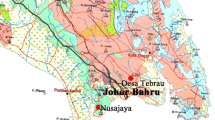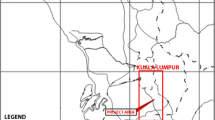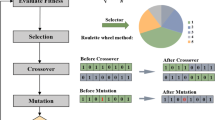Abstract
Reliable determination/evaluation of the rock deformation can be useful prior any structural design application. Young’s modulus (E) affords great insight into the characteristics of the rock. However, its direct determination in the laboratory is costly and time-consuming. Therefore, rock deformation prediction through indirect techniques is greatly suggested. This paper describes hybrid particle swarm optimization (PSO)–artificial neural network (ANN) and imperialism competitive algorithm (ICA)–ANN to solve shortcomings of ANN itself. In fact, the influence of PSO and ICA on ANN results in predicting E was studied in this research. By investigating the related studies, the most important parameters of PSO and ICA were identified and a series of parametric studies for their determination were conducted. All models were built using three inputs (Schmidt hammer rebound number, point load index and p-wave velocity) and one output which is E. To have a fair comparison and to show the capability of the hybrid models, a pre-developed ANN model was also constructed to estimate E. Evaluation of the obtained results demonstrated that a higher ability of E prediction is received developing a hybrid ICA–ANN model. Coefficient of determination (R2) values of (0.952, 0.943 and 0.753) and (0.955, 0.949 and 0.712) were obtained for training and testing of ICA–ANN, PSO–ANN and ANN models, respectively. In addition, VAF values near to 100 (95.182 and 95.143 for train and test) were achieved for a developed ICA–ANN hybrid model. The results indicated that the proposed ICA–ANN model can be implemented better in improving performance capacity of ANN model compared to another implemented hybrid model.










Similar content being viewed by others
References
Armaghani DJ, Mohamad ET, Momeni E et al (2016) Prediction of the strength and elasticity modulus of granite through an expert artificial neural network. Arab J Geosci 9:48
Yesiloglu-Gultekin N, Gokceoglu C, Sezer EA (2013) Prediction of uniaxial compressive strength of granitic rocks by various nonlinear tools and comparison of their performances. Int J Rock Mech Min Sci. https://doi.org/10.1016/j.ijrmms.2013.05.005
Singh R, Kainthola A, Singh TN (2012) Estimation of elastic constant of rocks using an ANFIS approach. Appl Soft Comput 12:40–45
Yilmaz I, Yuksek G (2009) Prediction of the strength and elasticity modulus of gypsum using multiple regression, ANN, and ANFIS models. Int J Rock Mech Min Sci 46:803–810
Ulusay R, Hudson JAISRM (2007) The complete ISRM suggested methods for rock characterization, testing and monitoring: 1974–2006. Comm. Test. methods. Int. Soc. Rock Mech. Compil. arranged by ISRM Turkish Natl. Group. Ankara, p 628
Gokceoglu C, Zorlu K (2004) A fuzzy model to predict the uniaxial compressive strength and the modulus of elasticity of a problematic rock. Eng Appl Artif Intell 17:61–72
Baykasoğlu A, Güllü H, Çanakçı H, Özbakır L (2008) Prediction of compressive and tensile strength of limestone via genetic programming. Expert Syst Appl 35:111–123
Jahed Armaghani D, Mohd Amin MF, Yagiz S et al (2016) Prediction of the uniaxial compressive strength of sandstone using various modeling techniques. Int J Rock Mech Min Sci. https://doi.org/10.1016/j.ijrmms.2016.03.018
Jahed Armaghani D, Tonnizam Mohamad E, Hajihassani M et al (2016) Application of several non-linear prediction tools for estimating uniaxial compressive strength of granitic rocks and comparison of their performances. Eng Comput. https://doi.org/10.1007/s00366-015-0410-5
Gokceoglu C (2002) A fuzzy triangular chart to predict the uniaxial compressive strength of the Ankara agglomerates from their petrographic composition. Eng Geol 66:39–51
Singh TN, Kanchan R, Saigal K, Verma AK (2004) Prediction of p-wave velocity and anisotropic property of rock using artificial neural network technique. J Sci Ind Res (India) 63:28–32
Kahraman S, Altun H, Tezekici B (2006) Sawability prediction of carbonate rocks from shear strength parameters using artificial neural networks. Int J Rock Mech Min Sci 43:157–164
Nazir R, Momeni E, Armaghani DJ, Amin MFM (2013) Correlation between unconfined compressive strength and indirect tensile strength of limestone rock samples. Electron J Geotech Eng 18:1737–1746
Nazir R, Momeni E, Armaghani DJ, Amin MFM (2013) Prediction of unconfined compressive strength of limestone rock samples using l-type schmidt hammer. Electron J Geotech Eng 18:1767–1775
Liu Z, Shao J, Xu W, Wu Q (2015) Indirect estimation of unconfined compressive strength of carbonate rocks using extreme learning machine. Acta Geotech 10:651–663
Yazdani Bejarbaneh B, Jahed Armaghani D, Mohd Amin MF (2015) Strength characterisation of shale using Mohr-Coulomb and Hoek-Brown criteria. Meas J Int Meas Confed. https://doi.org/10.1016/j.measurement.2014.12.029
Jahed Armaghani D, Hajihassani M, Yazdani Bejarbaneh B et al (2014) Indirect measure of shale shear strength parameters by means of rock index tests through an optimized artificial neural network. Meas J Int Meas Confed 55:487–498. https://doi.org/10.1016/j.measurement.2014.06.001
Rezaei M, Majdi A, Monjezi M (2014) An intelligent approach to predict unconfined compressive strength of rock surrounding access tunnels in longwall coal mining. Neural Comput. Appl 24:233–241
Zorlu K, Gokceoglu C, Ocakoglu F et al (2008) Prediction of uniaxial compressive strength of sandstones using petrography-based models. Eng Geol 96:141–158
Mohamad ET, Armaghani DJ, Momeni E et al (2016) Rock strength estimation: a PSO-based BP approach. Neural Comput Appl. https://doi.org/10.1007/s00521-016-2728-3
Bejarbaneh BY, Bejarbaneh EY, Amin MFM et al (2016) Intelligent modelling of sandstone deformation behaviour using fuzzy logic and neural network systems. Bull Eng Geol Environ. https://doi.org/10.1007/s10064-016-0983-2
Liang M, Mohamad ET, Faradonbeh RS et al (2016) Rock strength assessment based on regression tree technique. Eng Comput. https://doi.org/10.1007/s00366-015-0429-7
Jahed Armaghani D, Safari V, Fahimifar A et al (2017) Uniaxial compressive strength prediction through a new technique based on gene expression programming. Neural Comput Appl. https://doi.org/10.1007/s00521-017-2939-2
Meulenkamp F, Grima M (1999) Application of neural networks for the prediction of the unconfined compressive strength (UCS) from Equotip hardness. Int J Rock Mech 36:29–39
Mohamad ET, Armaghani DJ, Hajihassani M et al (2013) A simulation approach to predict blasting-induced flyrock and size of thrown rocks. Electron J Geotech Eng 18 B:365–374
Armaghani DJ, Mohamad ET, Narayanasamy MS et al (2017) Development of hybrid intelligent models for predicting TBM penetration rate in hard rock condition. Tunn Undergr Sp Technol 63:29–43. https://doi.org/10.1016/j.tust.2016.12.009
Mohamad ET, Faradonbeh RS, Armaghani DJ, Monjezi M, Majid MZA (2017) An optimized ANN model based on genetic algorithm for predicting ripping production. Neural Comput Appl 28(1):393–406
Tonnizam Mohamad E, Hajihassani M, Jahed Armaghani D, Marto A (2012) Simulation of blasting-induced air overpressure by means of Artificial Neural Networks. Int Rev Model Simul 5:2501–2506
Shams S, Monjezi M, Majd VJ, Armaghani DJ (2015) Application of fuzzy inference system for prediction of rock fragmentation induced by blasting. Arab J Geosci 8:10819–10832
Hasanipanah M, Jahed Armaghani D, Khamesi H et al (2016) Several non-linear models in estimating air-overpressure resulting from mine blasting. Eng Comput. https://doi.org/10.1007/s00366-015-0425-y
Singh TN, Verma AK (2012) Comparative analysis of intelligent algorithms to correlate strength and petrographic properties of some schistose rocks. Eng Comput 28:1–12
Verma AK, Singh TN (2013) A neuro-fuzzy approach for prediction of longitudinal wave velocity. Neural Comput Appl 22:1685–1693
Singh J, Verma AK, Banka H et al (2016) A study of soft computing models for prediction of longitudinal wave velocity. Arab J Geosci 9:1–11
Khandelwal M, Singh TN (2009) Prediction of blast-induced ground vibration using artificial neural network. Int J Rock Mech Min Sci 46:1214–1222
Momeni E, Nazir R, Armaghani DJ, Maizir H (2015) Application of artificial neural network for predicting shaft and tip resistances of concrete piles. Earth Sci Res J 19:85–93
Jahed Armaghani D, Hasanipanah M, Mahdiyar A et al (2016) Airblast prediction through a hybrid genetic algorithm-ANN model. Neural Comput Appl. https://doi.org/10.1007/s00521-016-2598-8
Eberhart R, Shi Y (1998) Evolving artificial neural networks. Proc Int Conf Neural Netw Brain 1:PL5–PL13
Adhikari R, Agrawal R (2011) Effectiveness of PSO based neural network for seasonal time series forecasting. IICAI 3:231–244
Rukhaiyar S, Alam MN, Samadhiya NK (2017) A PSO–ANN hybrid model for predicting factor of safety of slope. Int J Geotech Eng. https://doi.org/10.1080/19386362.2017.1305652
Hasanipanah M, Jahed Armaghani D, Bakhshandeh Amnieh H et al (2016) Application of PSO to develop a powerful equation for prediction of flyrock due to blasting. Neural Comput Appl. https://doi.org/10.1007/s00521-016-2434-1
Ren C, An N, Wang J et al (2014) Optimal parameters selection for BP neural network based on particle swarm optimization: a case study of wind speed forecasting. Knowl Based Syst. https://doi.org/10.1016/j.knosys.2013.11.015
Moayedi H, Jahed Armaghani D (2017) Optimizing an ANN model with ICA for estimating bearing capacity of driven pile in cohesionless soil. Eng Comput. https://doi.org/10.1007/s00366-017-0545-7
Khandelwal M, Mahdiyar A, Armaghani DJ et al (2017) An expert system based on hybrid ICA–ANN technique to estimate macerals contents of Indian coals. Environ Earth Sci 76:399. https://doi.org/10.1007/s12665-017-6726-2
Simpson PK (1990) Artificial neural systems: foundations, paradigms, applications, and implementations. Pergamon
McCulloch WS, Pitts W (1943) A logical calculus of the ideas immanent in nervous activity. Bull Math Biophys 5:115–133
Demuth H, Beale M (2000) Neural network toolbox: for use with Matlab: computation, visualization, programming: User’s Guide, version 4. The MathWorks
Hasanipanah M, Noorian-Bidgoli M, Jahed Armaghani D, Khamesi H (2016) Feasibility of PSO–ANN model for predicting surface settlement caused by tunneling. Eng Comput. https://doi.org/10.1007/s00366-016-0447-0
Abad ANezhadK, Yilmaz SV, Jahed Armaghani M, Tugrul D A (2016) Prediction of the durability of limestone aggregates using computational techniques. Neural Comput Appl. https://doi.org/10.1007/s00521-016-2456-8
Haykin S (1999) Neural networks: a comprehensive foundation. Prentice Hall, Upper Saddle River
Dreyfus G (2005) Neural networks: methodology and applications. Springer, Berlin
Kennedy J, Eberhart RC (1995) A discrete binary version of the particle swarm algorithm. In: Syst. Man, Cybern. Comput. Cybern. Simulation. 1997 IEEE Int. Conf, IEEE, pp 4104–4108
Yang X-S (2010) Engineering optimization: an introduction with metaheuristic applications. Wiley, New york
Atashpaz-Gargari E, Lucas C (2007) Imperialist competitive algorithm: an algorithm for optimization inspired by imperialistic competition. Evol. Comput. 2007. CEC 2007. IEEE Congr. IEEE, pp 4661–4667
Jahed Armaghani D, Hasanipanah M, Tonnizam Mohamad E (2016) A combination of the ICA–ANN model to predict air-overpressure resulting from blasting. Eng Comput. https://doi.org/10.1007/s00366-015-0408-z
Ahmadi MA, Ebadi M, Shokrollahi A, Majidi SMJ (2013) Evolving artificial neural network and imperialist competitive algorithm for prediction oil flow rate of the reservoir. Appl Soft Comput 13:1085–1098
Jahed Armaghani D, Mohd Amin MF, Yagiz S et al (2016) Prediction of the uniaxial compressive strength of sandstone using various modeling techniques. Int J Rock Mech Min Sci 85:174–186. https://doi.org/10.1016/j.ijrmms.2016.03.018
Taghavifar H, Mardani A, Taghavifar L (2013) A hybridized artificial neural network and imperialist competitive algorithm optimization approach for prediction of soil compaction in soil bin facility. Measurement 46:2288–2299
Khandelwal M, Marto A, Fatemi SA et al (2017) Implementing an ANN model optimized by genetic algorithm for estimating cohesion of limestone samples. Eng Comput. https://doi.org/10.1007/s00366-017-0541-y
Yagiz S, Karahan H (2011) Prediction of hard rock TBM penetration rate using particle swarm optimization. Int J Rock Mech Min Sci 48:427–433
Taheri K, Hasanipanah M, Bagheri Golzar S, Abd Majid MZ (2016) A hybrid artificial bee colony algorithm-artificial neural network for forecasting the blast-produced ground vibration. Eng Comput. https://doi.org/10.1007/s00366-016-0497-3
Koopialipoor M, Armaghani DJ, Haghighi M, Ghaleini EN (2017) A neuro-genetic predictive model to approximate overbreak induced by drilling and blasting operation in tunnels. Bull Eng Geol Environ. https://doi.org/10.1007/s10064-017-1116-2
Shirani Faradonbeh R, Monjezi M, Jahed Armaghani D (2016) Genetic programing and non-linear multiple regression techniques to predict backbreak in blasting operation. Eng Comput. https://doi.org/10.1007/s00366-015-0404-3
Hajihassani M, Jahed Armaghani D, Marto A, Tonnizam Mohamad E (2015) Ground vibration prediction in quarry blasting through an artificial neural network optimized by imperialist competitive algorithm. Bull Eng Geol Environ. https://doi.org/10.1007/s10064-014-0657-x
Marto A, Hajihassani M, Jahed Armaghani D et al (2014) A novel approach for blast-induced flyrock prediction based on imperialist competitive algorithm and artificial neural network. Sci World J. https://doi.org/10.1155/2014/643715
Jahed Armaghani D, Hajihassani M, Marto A et al (2015) Prediction of blast-induced air overpressure: a hybrid AI-based predictive model. Environ Monit Assess. https://doi.org/10.1007/s10661-015-4895-6
Khandelwal M, Armaghani DJ (2016) Prediction of Drillability of Rocks with Strength Properties Using a Hybrid GA-ANN Technique. Geotech Geol Eng 34:605–620. https://doi.org/10.1007/s10706-015-9970-9
Saghatforoush A, Monjezi M, Shirani Faradonbeh R, Jahed Armaghani D (2016) Combination of neural network and ant colony optimization algorithms for prediction and optimization of flyrock and back-break induced by blasting. Eng Comput. https://doi.org/10.1007/s00366-015-0415-0
Liou S-W, Wang C-M, Huang Y-F (2009) Integrative discovery of multifaceted sequence patterns by frame-relayed search and hybrid PSO–ANN. J UCS 15:742–764
Nelson MM, Illingworth WT (1991) A practical guide to neural nets. Addison-Wesley, Reading
Jahed Armaghani D, Shoib RSNSBR., Faizi K, Rashid ASA (2017) Developing a hybrid PSO–ANN model for estimating the ultimate bearing capacity of rock-socketed piles. Neural Comput Appl. https://doi.org/10.1007/s00521-015-2072-z
Hornik K, Stinchcombe M, White H (1989) Multilayer feedforward networks are universal approximators. Neural Netw 2:359–366
Clerc M, Kennedy J (2002) The particle swarm-explosion, stability, and convergence in a multidimensional complex space. IEEE Trans Evol Comput 6:58–73
Armaghani DJ, Mahdiyar A, Hasanipanah M et al (2016) Risk assessment and prediction of Flyrock distance by combined multiple regression analysis and Monte Carlo simulation of quarry blasting. Rock Mech Rock Eng 49:1–11. https://doi.org/10.1007/s00603-016-1015-z
Armaghani D, Mohamad E, Hajihassani M (2016) Evaluation and prediction of flyrock resulting from blasting operations using empirical and computational methods. Eng Comput 32:109–121
Beiki M, Majdi A, Givshad A (2013) Application of genetic programming to predict the uniaxial compressive strength and elastic modulus of carbonate rocks. J Rock Mech Min 63:159–169
Acknowledgements
This work was financially supported by the National Key Research and Development Plan (2016YFC0501103), Natural Science Foundation of Jiangsu Province (BK20160259), National Natural Science Foundation of China (51774271), National Natural Science Foundation of China (No. 51674245), Priority Academic Program Development of Jiangsu Higher Education Institutions (PAPD), the Fundamental Research Funds for the Central Universities (No. 2014XT01).
Author information
Authors and Affiliations
Corresponding author
Rights and permissions
About this article
Cite this article
Tian, H., Shu, J. & Han, L. The effect of ICA and PSO on ANN results in approximating elasticity modulus of rock material. Engineering with Computers 35, 305–314 (2019). https://doi.org/10.1007/s00366-018-0600-z
Received:
Accepted:
Published:
Issue Date:
DOI: https://doi.org/10.1007/s00366-018-0600-z




